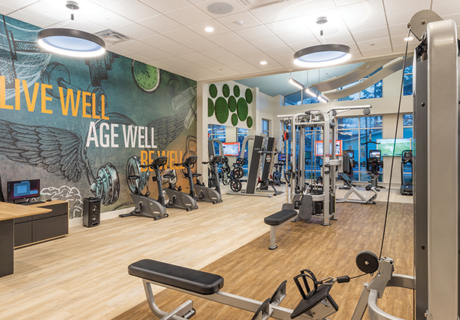Redefining The Golden Years
As part of Perkins Eastman’s year-long The Clean Slate Project, co-sponsored by J+J Flooring Group, the firm is exploring the senior living market through fresh eyes, looking to other sectors to inspire unforeseen innovations in this industry.
In this article, the third in a four-part series, we look at how the traditional concept of retirement is being upended and why baby boomers are seeking “third acts” that involve entrepreneurship, new business ventures, lifelong learning, volunteering, and other adventures.
Baby boomers comprise a culturally and economically diverse set of the U.S. population, which—when coupled with longer life expectancy than previous generations—translates into a retirement that doesn’t fit any traditional mold or standard. In fact, the word “retirement” is no longer apt given that many boomers are choosing not to leave the workforce while others are radically reinventing themselves and opting instead to begin a “third act” of life.
Third acts can include transitions into the shared economy, such as becoming a contractor with Uber or Task Rabbit, or specialized consulting jobs that match up well with their current job or past careers. For those seniors who are able and willing to leave the 9-to-5 behind but aren’t looking to hang up their hat, many are filling their third acts with volunteer opportunities that match up with their personal pursuits and passions.
Additionally, older adults are increasingly seeking daily routines that enable them to connect with people of all ages and are forging living and working arrangements that are intergenerational. Some residential communities have taken note, such as Pat Crowley House in Chicago, which groups independent living apartments with market-rate apartments designed for families, students, and young professionals. Another example is Providence Mount St. Vincent in Seattle, which houses a nursing care facility and a preschool program, thus encouraging social engagement between older adults and children.
Where boomers are choosing to spend their third acts is also challenging our ideas of what traditionally constitutes retirement. Rather than making the customary transition to warmer climates like Florida or Arizona, many older adults are instead seeking less traditional locales, whether it’s urban centers like New York or Chicago or relocating to countries outside the U.S., looking to save on healthcare costs or simply wanting a lifestyle change. While this can be a drastic change (and culture shock!) for many, living in a virtually connected world has made such transitions much less stressful.
Many are exercising a level of autonomy that until now was just wishful thinking, discovering new ways to live in a world where services and amenities are coming to them, rather than the other way around. Boomers are taking charge of their social well-being in new ways, using dating and social apps, utilizing virtual assistants to assist with managing personal calendars as well as basic healthcare needs, and even working remotely.
Technological innovations have also improved the efficiency of healthcare delivery and wellness services, while enabling people to access these services remotely. Examples include companies like Peloton, which brings the atmosphere of a group fitness class into your home; the app InstaCart, which allows online shoppers to buy groceries and fresh produce from their local markets; and Honor, which enables older adults and families to customize home-based care plans and choose from a list of qualified care professionals in their area. Even the company Fitbit is looking beyond fitness trackers and creating a line of wearable devices that can monitor heart rates and sync to smart-home devices like Amazon Echo and other virtual assistants.
Such devices and companies are meeting the needs of people who have every intention of maintaining their independence and living life on their terms—and boomers very much seem to fit that mold.
The traditional senior living model comprises three basic components—residential, socialization, and wellness/healthcare—with the understanding that accessing these components would require a person to be in a single location where all these mutually dependent services converge. However, today’s reality paints a much different picture as housekeeping, social settings, healthcare services, and practically everything in between can be accessed from just about anywhere and delivered à la carte.
As market expectations have changed drastically, the senior living industry is obliged to respond in ways that are nimble and creative, whether that means outsourcing services in the form of in-home healthcare or partnering with local organizations (i.e. healthcare, higher education) to make their communities more appealing.
While some providers have already made these and similar adjustments, the greater question remains: Will the senior living marketplace be able to pivot in response to consumers’ evolving preferences and lifestyles, like a Netflix, or will it stand its ground and insist on business as usual, like a Blockbuster Video? Every conceivable indicator points to the fact that less traditional third acts will only broaden in their appeal to this rapidly aging consumer base. And if history has taught us anything, it’s that adaptability is the key to survival.
Emily Chmielewski is senior associate at Perkins Eastman (Pittsburgh). She can be reached at e.chmielewski@perkinseastman.com. Max Winters is an associate at Perkins Eastman (Pittsburgh). He can be reached at m.winters@perkinseastman.com.
Read additional articles in this series at efamagazine.com:
Making A Connection With Technology
Decentralizing Housing Options




